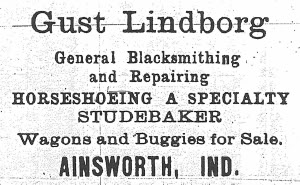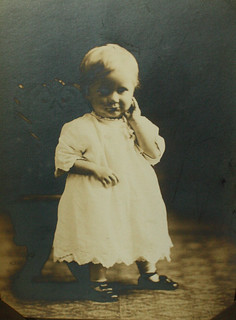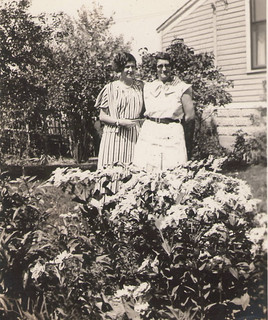I don't know whether the Saturday-night dances in Gust Lindborg's hall in Ainsworth continued through the years we've been speaking of lately. He placed dance advertisements only sporadically during the mid-teens. Perhaps the regular dances had become such an institution that they no longer needed advertisement, and Gust announced only special events — for example, these two in November 1915:
There will be a dance at Ainsworth, Nov. 6, and on the 20th, there will be a Masquerade ball at the Ainsworth hall. Admission to each is 50c, ladies free. Everybody invited. Bruebach orchestra.Or perhaps those special events were the only dances.
By contrast, the same little ad for Gust's blacksmith shop appeared in almost every issue of the Gazette.

That business was coming along well enough to provide a decent living for his family. Gust shoed the horses of his farming neighbors, sharpened their plowshares and repaired their farm machinery, and sold them new machinery and wagons. He also did work for the township, repairing road-maintenance equipment and school buses.
In May of 1916, the Lindborg family increased in size. A daughter, Norma Annabelle, was born on May 26.

(Click on image to enlarge)
Norma Lindborg at about two years of age. (Image from a private collection.)
After the medical problems that had plagued her in 1911, Anna Lindborg seems to have recovered her health. She needed it, too. Keeping a house was hard labor in 1916, and Anna did not have a maid.
The house had no running water. A hand pump at the kitchen sink in the basement, drawing from a rainwater cistern, was the only indoor source of water, and even so Anna was probably grateful that she didn't have to haul water from an outdoor pump. The only regular source of hot water for the household was a tank built into the side of the kitchen stove, which had to be filled by hand. Once the water heated up, Anna could fill a bucket to carry wherever the hot water was needed. The stove burned wood or coal. That meant loading up the fuel and lighting a fire for every day's use, and every day cleaning out the ashes.
At that stove Anna prepared all the family's meals. A good part of their food came from the big garden out in the backyard, near the Grand Trunk tracks. That garden had to be tended all summer, of course, and its produce harvested as it ripened. Anna canned all the surplus vegetables from the garden, and fruit in season when she could buy it cheaply. Canning was a lot of work — she had to clean, perhaps peel and slice up the vegetables or fruit, and then came the heat-processing and sealing of the glass jars. Once the jars cooled, they had to be carried into the basement storage room. And all of this took place during the height of summer, in a house with not so much as an electric fan.
The potatoes were relatively easy: they just had to be dug from the ground and carried down to a big wooden bin in the basement.
The Lindborgs raised their own chickens, so there was the additional work of tending to them and gathering eggs. They raised hogs as well. Every now and then Gust would slaughter a hog, and then Anna set about preserving the meat. Some of it she canned; some she used to make sausage. For that she had a hand-grinder, clamped to the kitchen table. She cut up the meat, mixed it with seasonings, and loaded the mixture into the hopper, then, turning the crank by hand, filled the casings from the spout.
Anna washed the laundry by hand and hung it out on lines in the backyard to dry. She probably began with just a tub and washboard, although eventually she got a washing "machine" that included a hand-cranked agitator and attached wringer. Any pressing was done with a heavy flatiron heated on the stove. Anna herself sewed much of the family's clothing on a treadle sewing machine, its only power source her foot on the treadle.
The house had to be cleaned, of course, and without the modern labor-saving devices. Vacuum cleaners were available in 1916, even models that did not require electricity, but the Lindborgs could not afford such a luxury. During the summer months Anna must have fought a daily battle against dust, since she lived near the center of Ainsworth commerce and the roads that led to it were, at best, only graveled.
Add to all this the hourly needs of three little children and an infant (in an era without disposable diapers), and you have a great deal of work on your hands. Frankly, I'm feeling tired just writing about it.
And yet, after all this work was done, Anna still found the time and energy to tend her flowers. Some part of the Lindborg yard was always devoted to plants that had no purpose but to be beautiful — peonies, roses, morning-glories, lilies and lilacs, just to name a few. Over the years, Anna nurtured and added to her flowers, creating a little haven of beauty in what was otherwise a rather dull and utilitarian landscape, and no doubt adding hours of labor on top of her other chores. But to her it was worth the trouble.

(Click on image to enlarge)
Anna's flowers were in full bloom on this summer day, probably in the late 1920s, when two visitors posed for a photo on the west side of the Lindborg house. (Image from a private collection.)
Some years later, Anna told her children a story on herself. When she first came to this country from Sweden, she knew only a few words of English. She had to find work at once to support herself, and learn English on the job.
She landed work as a maid in a private household. One day the lady of the house gave her an order that seemed very odd indeed. Puzzled but obedient, Anna went to the kitchen, got a bowl from the cupboard, filled it with flour, then carried it out to the dining room and carefully placed it in the center of the table.
And then she wondered why her employer was laughing.
It was not, of course, a bowl of flour that the lady had asked for, but flowers. And that was how Anna learned the English word for blommor, those blossoming things she loved so much.
[To be continued]
Sources:
♦ "Personal and Local Mention." Hobart News 1 Jan. 1914; 25 Sept. 1914; 23 Oct. 1914; 12 Nov. 1914; 4 Nov. 1915.
♦ Personal interviews with a Lindborg descendent, Jan. – Oct. 2010.
♦ "Township Trustee's Annual Report." Hobart Gazette 21 Jan. 1916.


No comments:
Post a Comment